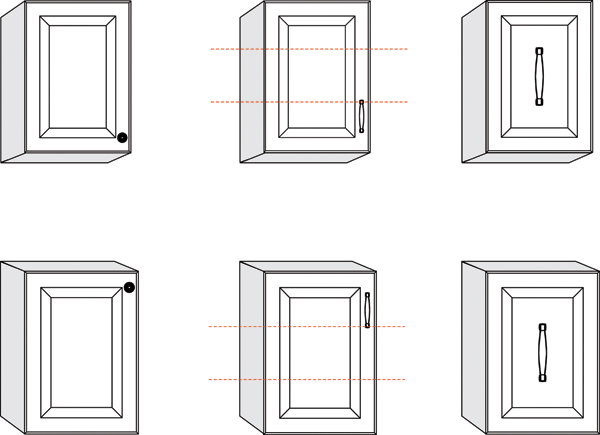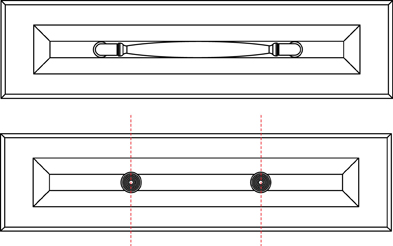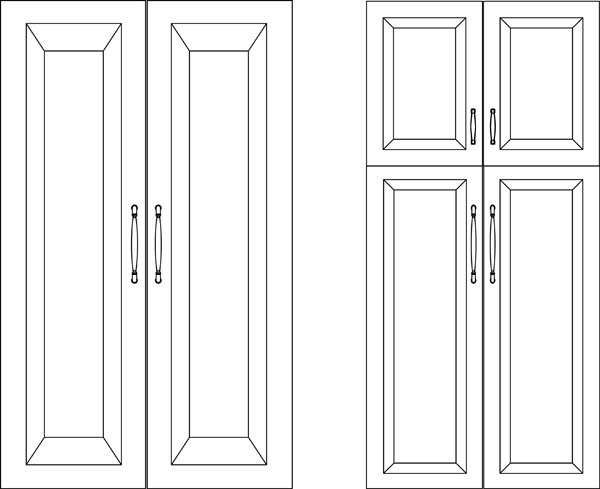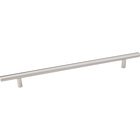Installing Cabinet Hardware
Cabinets
Traditionally, knobs are used on cabinet doors, and pulls (handles) are used on drawers. However, some kitchens may use all knobs or all pulls, or any combination that best suits your style.
When mounting knobs on cabinet doors, place the knob in the corner of the door.
When mounting pulls (handles) on cabinet doors, place the bottom hole in the upper third of the door for lower cabinets, and the upper hole in the lower third of the door for upper cabinets. Usually, hardware is placed on the door stile, but with some styles of doors, hardware placed in the center of the door can be an attractive option.
Best Knob and Pull Cabinet Placement Options

Drawers
When mounting pulls on drawers, align the holes in the center of the drawer front.

It may be helpful to purchase a pull installation template before you start working. This will allow you to mark where you should drill before you start working.
When it comes to re-using previously drilled holes, the following information should assist you:
• On wall cabinets, reuse the bottom hole and drill a new top hole• On base cabinets, reuse the top hole and drill a new bottom hole
• On drawers, drill two new holes and realign in the center
On wide drawers, sometimes smaller pieces of hardware can get lost. We recommend using an appliance pull or two smaller pieces of hardware for these applications. When using two smaller pieces of hardware, the pieces should be mounted on the thirds. This will keep them from being too far apart.

Pantry
When mounting an appliance pulls on a pantry or other tall cabinet door, we recommend mounting the hardware at the elbow level of an adult. This will make it comfortable to use, and allow children to still reach it. Depending on the height of the door, ths may or may not put the hardware in the middle of the door.

Replacing the cabinet hardware in a kitchen is the quickest and most inexpensive way to update the look of your kitchen.
Cup Pulls
Cup pulls can make it easy to pull open drawers and add a chic and modern vibe to any kitchen. However, cup pulls don't work on all types of drawers. Thin drawers can look clunky with a cup pull and it can be difficult to reach your fingers underneath the pull if a thin drawer has an inset. Standard-sized drawers with a deep inset don't work well with cup pulls simply because you have to reach your hand in far to reach the pull. Bar pulls or knobs would work better for those types of drawers.
Backplates
Backplates are used along with a knob or a pull. They serve a variety of purposes, the most important one to protect the wood surface from dents and stratches. They also help cover exposed holes or damage caused by older cabinet hardware. Some people install backplates simply for the aesthetic effect.
Adjustable Pulls
Adjustable pulls are pulls that allow you to change the length of the pull. These are perfect for drawers and cabinets that have odd sized holes from previous hardware.
Appliance Pulls
Standard pulls should never be used on appliances like refrigerators and dishwashers -- they can't handle the weight of a heavy door. Appliance pulls are incredibly sturdy in order to handle the weight of appliance doors and can put up with heavy use.
Common sizes of appliance pulls are as follows:
Small (dishwashers, wine coolers): 6-8"Large (refrigerators): Greater than 10, but 12" is standard.




